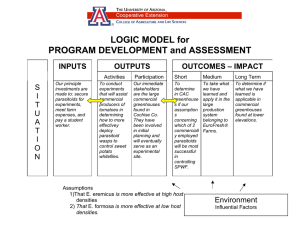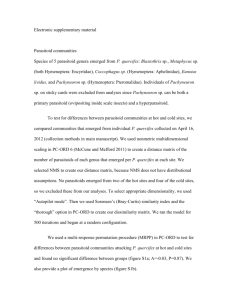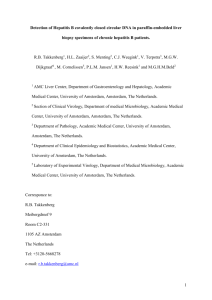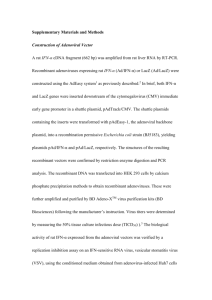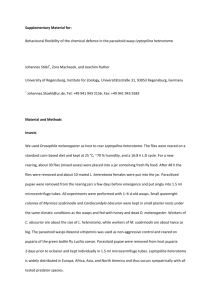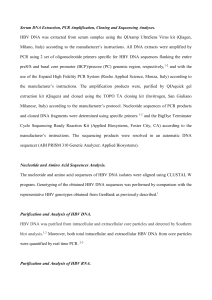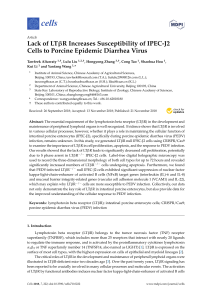PERSPECTIVES
advertisement
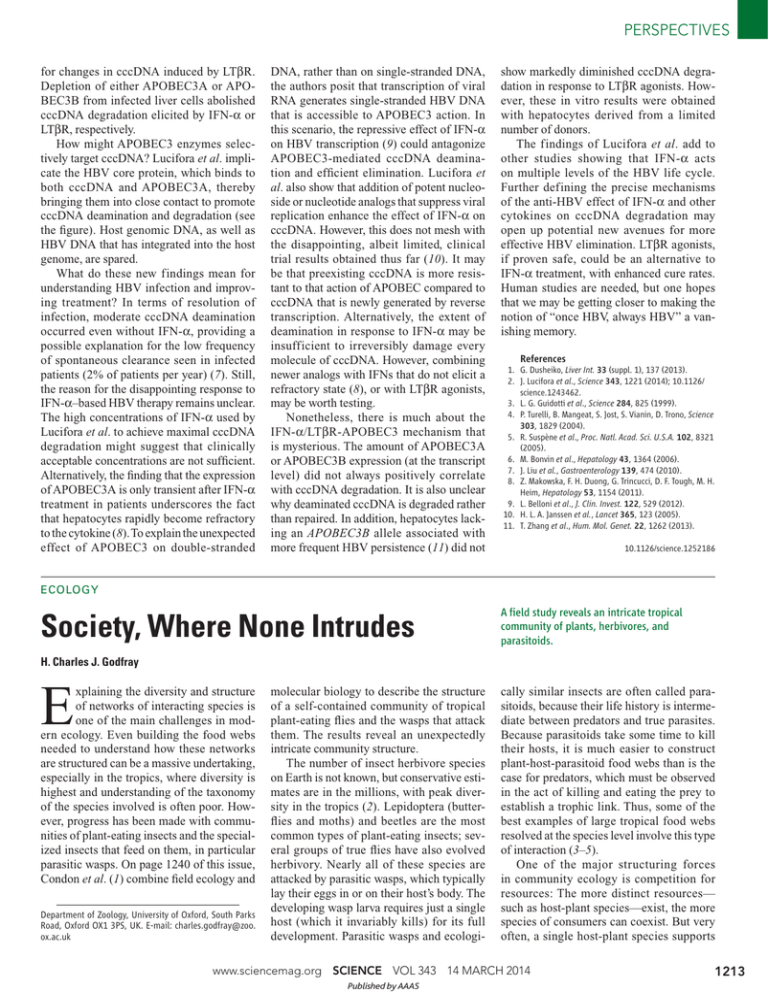
PERSPECTIVES for changes in cccDNA induced by LTβR. Depletion of either APOBEC3A or APOBEC3B from infected liver cells abolished cccDNA degradation elicited by IFN-α or LTβR, respectively. How might APOBEC3 enzymes selectively target cccDNA? Lucifora et al. implicate the HBV core protein, which binds to both cccDNA and APOBEC3A, thereby bringing them into close contact to promote cccDNA deamination and degradation (see the figure). Host genomic DNA, as well as HBV DNA that has integrated into the host genome, are spared. What do these new findings mean for understanding HBV infection and improving treatment? In terms of resolution of infection, moderate cccDNA deamination occurred even without IFN-α, providing a possible explanation for the low frequency of spontaneous clearance seen in infected patients (2% of patients per year) (7). Still, the reason for the disappointing response to IFN-α–based HBV therapy remains unclear. The high concentrations of IFN-α used by Lucifora et al. to achieve maximal cccDNA degradation might suggest that clinically acceptable concentrations are not sufficient. Alternatively, the finding that the expression of APOBEC3A is only transient after IFN-α treatment in patients underscores the fact that hepatocytes rapidly become refractory to the cytokine (8). To explain the unexpected effect of APOBEC3 on double-stranded DNA, rather than on single-stranded DNA, the authors posit that transcription of viral RNA generates single-stranded HBV DNA that is accessible to APOBEC3 action. In this scenario, the repressive effect of IFN-α on HBV transcription (9) could antagonize APOBEC3-mediated cccDNA deamination and efficient elimination. Lucifora et al. also show that addition of potent nucleoside or nucleotide analogs that suppress viral replication enhance the effect of IFN-α on cccDNA. However, this does not mesh with the disappointing, albeit limited, clinical trial results obtained thus far (10). It may be that preexisting cccDNA is more resistant to that action of APOBEC compared to cccDNA that is newly generated by reverse transcription. Alternatively, the extent of deamination in response to IFN-α may be insufficient to irreversibly damage every molecule of cccDNA. However, combining newer analogs with IFNs that do not elicit a refractory state (8), or with LTβR agonists, may be worth testing. Nonetheless, there is much about the IFN-α/LTβR-APOBEC3 mechanism that is mysterious. The amount of APOBEC3A or APOBEC3B expression (at the transcript level) did not always positively correlate with cccDNA degradation. It is also unclear why deaminated cccDNA is degraded rather than repaired. In addition, hepatocytes lacking an APOBEC3B allele associated with more frequent HBV persistence (11) did not show markedly diminished cccDNA degradation in response to LTβR agonists. However, these in vitro results were obtained with hepatocytes derived from a limited number of donors. The findings of Lucifora et al. add to other studies showing that IFN-α acts on multiple levels of the HBV life cycle. Further defining the precise mechanisms of the anti-HBV effect of IFN-α and other cytokines on cccDNA degradation may open up potential new avenues for more effective HBV elimination. LTβR agonists, if proven safe, could be an alternative to IFN-α treatment, with enhanced cure rates. Human studies are needed, but one hopes that we may be getting closer to making the notion of “once HBV, always HBV” a vanishing memory. References 1. G. Dusheiko, Liver Int. 33 (suppl. 1), 137 (2013). 2. J. Lucifora et al., Science 343, 1221 (2014); 10.1126/ science.1243462. 3. L. G. Guidotti et al., Science 284, 825 (1999). 4. P. Turelli, B. Mangeat, S. Jost, S. Vianin, D. Trono, Science 303, 1829 (2004). 5. R. Suspène et al., Proc. Natl. Acad. Sci. U.S.A. 102, 8321 (2005). 6. M. Bonvin et al., Hepatology 43, 1364 (2006). 7. J. Liu et al., Gastroenterology 139, 474 (2010). 8. Z. Makowska, F. H. Duong, G. Trincucci, D. F. Tough, M. H. Heim, Hepatology 53, 1154 (2011). 9. L. Belloni et al., J. Clin. Invest. 122, 529 (2012). 10. H. L. A. Janssen et al., Lancet 365, 123 (2005). 11. T. Zhang et al., Hum. Mol. Genet. 22, 1262 (2013). 10.1126/science.1252186 ECOLOGY Society, Where None Intrudes A field study reveals an intricate tropical community of plants, herbivores, and parasitoids. H. Charles J. Godfray E xplaining the diversity and structure of networks of interacting species is one of the main challenges in modern ecology. Even building the food webs needed to understand how these networks are structured can be a massive undertaking, especially in the tropics, where diversity is highest and understanding of the taxonomy of the species involved is often poor. However, progress has been made with communities of plant-eating insects and the specialized insects that feed on them, in particular parasitic wasps. On page 1240 of this issue, Condon et al. (1) combine field ecology and Department of Zoology, University of Oxford, South Parks Road, Oxford OX1 3PS, UK. E-mail: charles.godfray@zoo. ox.ac.uk molecular biology to describe the structure of a self-contained community of tropical plant-eating flies and the wasps that attack them. The results reveal an unexpectedly intricate community structure. The number of insect herbivore species on Earth is not known, but conservative estimates are in the millions, with peak diversity in the tropics (2). Lepidoptera (butterflies and moths) and beetles are the most common types of plant-eating insects; several groups of true flies have also evolved herbivory. Nearly all of these species are attacked by parasitic wasps, which typically lay their eggs in or on their host’s body. The developing wasp larva requires just a single host (which it invariably kills) for its full development. Parasitic wasps and ecologi- cally similar insects are often called parasitoids, because their life history is intermediate between predators and true parasites. Because parasitoids take some time to kill their hosts, it is much easier to construct plant-host-parasitoid food webs than is the case for predators, which must be observed in the act of killing and eating the prey to establish a trophic link. Thus, some of the best examples of large tropical food webs resolved at the species level involve this type of interaction (3–5). One of the major structuring forces in community ecology is competition for resources: The more distinct resources— such as host-plant species—exist, the more species of consumers can coexist. But very often, a single host-plant species supports www.sciencemag.org SCIENCE VOL 343 14 MARCH 2014 Published by AAAS 1213 PERSPECTIVES many species of specialist insect herbivores. Of course, different species may specialize by feeding on different plant organs, or the different species may feed on the plants at nonoverlapping times of year, but even taking this into account, there appear to be more consumers than distinct resource niches (6). But communities can also be structured by the actions of higher trophic levels— for example, the diseases, parasitoids, and predators that afflict plant-eating insects. Just as two consumer species cannot coexist in the long term on the same resource, with the less efficient competitor going extinct, so a natural enemy that attacks two species will drive the less resilient to extinction. Similarly, just as species are predicted to evolve to use unexploited resources, they are also expected to evolve into “enemy-free space”—ecological niches with few predators and parasitoids (7). This type of interaction between species mediated by shared natural enemies has been termed “apparent competition” (8) because its effects on community structure are similar to those of traditional resource competition. Experiments have shown that apparent competition occurs in insect food webs, including in the tropics (9). Condon et al. studied a type of fly (belonging to the family Tephritidae) whose larvae feed on the succulent parts of the flowers of climbing squashes (cucurbits). At their study site in Peru, two species of squash grew together; each had morphologically distinct male and female flowers. The fly larvae are attacked by tiny wasps, a few millimeters in length, that lay their eggs in young larvae. The eggs hatch and the wasp larvae remain in a state of suspended development until their hosts become full grown, when they resume growth and kill them. During the developmental hiatus, the host can fight back by mounting an immunological defense that, if successful, kills the internal parasitoid. The first surprise about this community was how many species were involved and how specialized they were. The authors reared 14 fly species, all in the same genus. Most species of fly specialized on only one of the four resource types—either a male or female flower of the two species. Up to 11 species shared a single resource type. A clue to how these species can coexist is provided by the 18 species of parasitoid wasps that were reared. They include two species that attack a broad range of hosts, but also a group of closely related species—all belonging to the same genus—that have very nar- 1214 Wasps Flies Flowers Females Flowers of Gurania acuminata Flowers of Gurania spinulosa Males Flies of the genus Blepharoneura Parasitoid wasps of the genus Bellopius Other parasitoid wasps Intricate web. At their study site, Condon et al. collected 3636 flowers from two species of squash. A total of 1106 flies and 163 parasitoid wasps emerged from the flowers. In the resulting food web, the three trophic levels are represented by rows of balls. Within each trophic level, the size of the balls and thickness of the links are proportional to the abundance of species and the strength of feeding links, respectively. Most wasp species can only develop in a single fly host species. row host ranges. These wasps were each restricted to develop in a single fly species, even when several host types were present. Such patterns are exactly what one expects if resource competition and apparent competition are structuring the community. Until recently, it has only been possible to record the parasitoids that have overcome host defenses, not those that have succumbed to, or have been outcompeted by, other parasitoid species. Using modern molecular techniques, it is now possible to detect the traces of unsuccessful parasitoid attacks, allowing interaction webs rather than trophic webs to be constructed (10). Condon et al. do this for the first time in a large tropical community. They find that although most parasitoid species only successfully develop in one host species, the searching females lay eggs in other species that feed on the same resource type but are able to successfully defend themselves against the parasitoid. This host specificity is again consistent with structuring by apparent competition, but it remains unclear why females lay eggs in the wrong host. Possibly, they cannot tell hosts apart; alternatively, laying eggs in the wrong host may be worthwhile because the opportunity cost of wasting an egg is low or because the offspring may survive in rare cases. Condon et al. provide a wonderful example of a “society, where none intrudes.” The web of interactions they reveal is complex and raises fascinating hypotheses about how different species influence each other’s dynamics, both directly and indirectly. These ideas need to be tested experimentally, and this system, compared to most other tropical communities, may be relatively easy to manipulate in the field. References 1. M. A. Condon et al, Science 343, 1240 (2014). 2. A. J. Hamilton et al., Am. Nat. 176, 90 (2010). 3. J. Memmott, H. C. J. Godfray, I. D. Gauld, J. Anim. Ecol. 63, 521 (1994). 4. J. Hrcek, S. E. Miller, J. B. Whitfield, H. Shima, V. Novotny, Oecologia 173, 521 (2013). 5. M. A. Smith et al., Proc. Natl. Acad. Sci. U.S.A. 105, 12359 (2008). 6. P. D. Colley, T. A. Kursar, Science 343, 35 (2014). 7. M. J. Jeffries, J. H. Lawton, Biol. J. Linn. Soc. London 23, 269 (1984). 8. R. D. Holt, Theor. Popul. Biol. 12, 197 (1977). 9. R. J. Morris, O. T. Lewis, H. C. J. Godfray, Nature 428, 310 (2004). 10. R. Kaartinen, G. N. Stone, J. Hearn, K. Lohse, T. Roslin, Ecol. Entomol. 35, 623 (2010). 14 MARCH 2014 VOL 343 SCIENCE www.sciencemag.org Published by AAAS 10.1126/science.1251275
